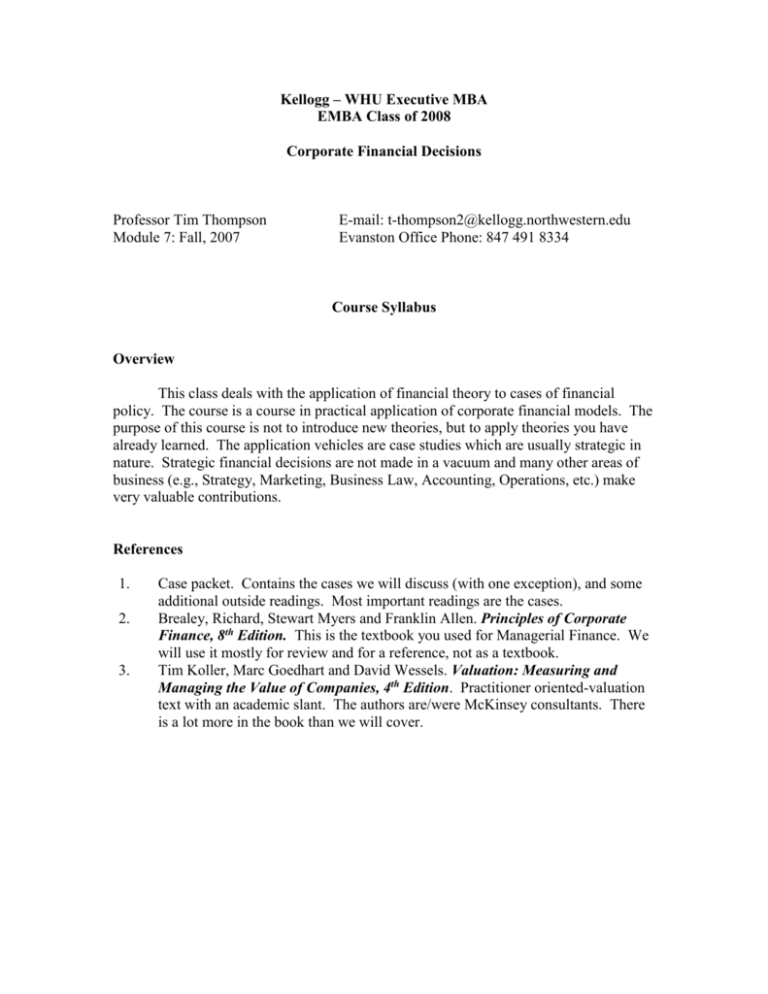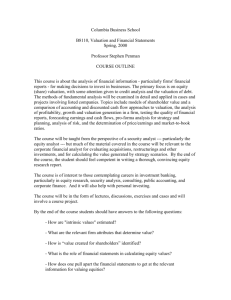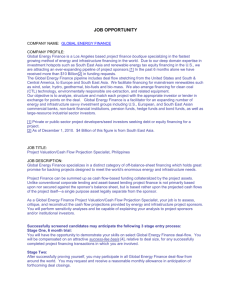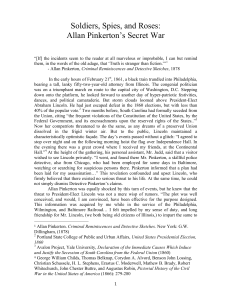WHU Executive MBA - Kellogg School of Management
advertisement

Kellogg – WHU Executive MBA EMBA Class of 2008 Corporate Financial Decisions Professor Tim Thompson Module 7: Fall, 2007 E-mail: t-thompson2@kellogg.northwestern.edu Evanston Office Phone: 847 491 8334 Course Syllabus Overview This class deals with the application of financial theory to cases of financial policy. The course is a course in practical application of corporate financial models. The purpose of this course is not to introduce new theories, but to apply theories you have already learned. The application vehicles are case studies which are usually strategic in nature. Strategic financial decisions are not made in a vacuum and many other areas of business (e.g., Strategy, Marketing, Business Law, Accounting, Operations, etc.) make very valuable contributions. References 1. 2. 3. Case packet. Contains the cases we will discuss (with one exception), and some additional outside readings. Most important readings are the cases. Brealey, Richard, Stewart Myers and Franklin Allen. Principles of Corporate Finance, 8th Edition. This is the textbook you used for Managerial Finance. We will use it mostly for review and for a reference, not as a textbook. Tim Koller, Marc Goedhart and David Wessels. Valuation: Measuring and Managing the Value of Companies, 4th Edition. Practitioner oriented-valuation text with an academic slant. The authors are/were McKinsey consultants. There is a lot more in the book than we will cover. Performance Evaluation Group evaluation 1. 2. 3. Bed Bath & Beyond case write up, 10% of course grade. Marriott, (WACC calculation for the hotel division), 5% of course grade. Major case write-up, Pinkerton (A) case, 15% of grade. Individual evaluation 4. 5. 6. Case write-up: (John Case Company, value the John Case Company), 20% of course grade. Final case write-up. Due by e-mail two weeks after end of the module, 40% of course grade. Class participation, 10% of the grade. Groups Much of the written work for this course will be done in groups. For this work, one paper will be turned in per group. The purpose of the group sessions is to enhance the learning experience for all group members, both by bringing different perspectives to bear on the cases and by raising the level of understanding of the material of all group members to a sufficient standard. Individual Assignments 70% of the course grade will be evaluated on an individual basis. At the end of our first weekend, I will assign the valuation of the John Case Company to be turned in at the beginning of our first session of the second weekend. On October 13, I will assign a final case to be handed in by e-mail to the EMBA office no later than 9:00 AM Monday, October 29. These assignments are to be done individually, not in groups. There will be no in-class final exam. Class participation Case classes are far more valuable when there is an active class discussion. Each case involves one or more strategic decisions that the CEO, CFO or board of directors must make. It is expected that class participants will be prepared to discuss any aspects of the decisions being made – in particular to support their recommendations to the class. The class participation component of the grade will be based on the quality of the student’s participation in class. Tim Thompson Page 2 3/3/20162 Philosophy on Required and Recommended Readings The only absolutely required readings for this course are the cases we cover (those in the case packet or distributed otherwise) and lecture materials (powerpoint presentations -either in the case packet or distributed otherwise -- and spreadsheet solutions -distributed in class and/or electronically available). There are other readings listed below in the syllabus, mostly from two textbooks. All the readings that are listed from your textbook from Managerial Finance (Principles of Corporate Finance, by Richard Brealey, Stewart Myers and Franklin Allen) are optional. In fact, they should be review: you should already have read them for Managerial Finance. All the readings from the textbook for this course (Valuation: Measuring and Managing the Value of Companies, by Timothy Koller, Marc Goedhart and David Wessels) are recommended, but not absolutely required. There are also tutorial materials on the web site that are intended to help the students with the case assignments, but these are also recommended, not absolutely required. The amount of assigned material from the text is relatively small and I think everyone in the class would benefit from reading the assigned material. What is meant by required and recommended in this context is “what do I need to read for the final.” For that question, everything you need to know to complete the final will be covered in class in the discussions of the cases we cover. There will be nothing on the final assignment(s) that will arise solely in the assigned readings, that if you didn’t read page XXX in the textbook, you wouldn’t know how to answer a question or do a calculation. On the other hand, the purpose of the readings is not to prepare you for a final examination, but to have supporting materials that allow the students to tailor their preparation and learning based on their backgrounds and based on their expectations. Some students have backgrounds in banking, corporate finance, etc., and many of the textbook readings and tutorial materials are unnecessary for them. Other students have no background in the material and the tutorial materials will be very helpful for them, as will the assigned chapters in the Valuation textbook. The former group can get away without reading a lot of the material. The latter will benefit far more from the readings. Some students want to use extensively the material we discuss in this course (corporate valuation, M&A methods, private equity investing, etc.) and will want to read far more than the assigned readings for the course --- the entire Valuation book will be of value to this group. Other students want to understand the basic framework of corporate valuation so they can be conversant in strategic decisions and corporate planning and board meetings involving expert presentations about valuation. The latter group will likely do the absolutely required readings and most of the recommended readings. Tim Thompson Page 3 3/3/20163 Course outline The following pages describe, in detail, the structure of each class session. For each date, the readings and assignments that should be completed by that date are listed. The topics that will be covered in each class session are listed next. In between the schedule pages are pages describing the specific case assignments. A quick overview is that the class is about valuation tools and their use in aiding strategic corporate financial decisions. Specifically, we will analyze financial structure decisions (leverage, internal vs. external equity ownership, etc.), merger and acquisitions, management buyouts, and corporate restructuring decisions. While we will discuss nondiscounted cash flow (DCF) methods of valuation (such as multiples), our main focus will be DCF valuation. The order of topics is as follows: 1. The impact of financial structure (e.g., leverage) on value with Bed Bath and Beyond; 2. how to estimate the cost of capital for projects, divisions, firms, acquisition candidates, with Marriott Corporation; 3. how to value a company based on its forecasted free cash flows in John Case Company – in this assignment, we assume a cost of capital and focus only on the future cash flows – we also use the predominant method of discounted cash flow: the WACC method; 4. we also use the John Case vehicle to discuss using comparable multiples for valuation and show that there is an alternative DCF method for valuing companies, called Adjusted Present Value (APV), which is more useful than the WACC method for some applications; 5. a case (to be determined, this case is not in the case packet) which will review a comprehensive strategic and financial evaluation of a company using multiples; 6. the Pinkerton case is a comprehensive case in valuing an acquisition target using the APV method, including forecasting cash flows, estimating the discount rate, estimating the value impact of financing structure, etc. Tim Thompson Page 4 3/3/20164 Schedule Saturday, October 6 Reading due by this date See the First Assignment Sheet. Assignments due by this date Group write-up of Bed, Bath and Beyond case, described on First Assignment Sheet. Session I: 9:00-10:30 Introduction to course. Discuss the Bed Bath and Beyond case. Session II: 10:45-12:15 Complete the Bed Bath and Beyond discussion. Introduce the Marriott WACC estimation exercise. Hand out an example of the WACC calculations for the Restaurant Division of Marriott. Assign the calculation of the WACC for the lodging division of Marriott, due Sunday, October 7, at 8:00, see next pages. Calculate the WACC for Marriott Corporate and for the Contract Services division for extra credit. Group assignment. One paper per group. Marriott Corporation: Cost of Capital The Marriott case assignment is simply to estimate the WACC for the lodging division. Be sure you show all your work. We also want to discuss Marriott’s four components of financial policy and their impact on corporate strategy, but this need not be addressed in your written work. Tim Thompson Page 5 3/3/20165 Sunday, October 7 Reading due by this date Chapter 5 of KGW. We will not use any of the material on Economic Profit methods, so these can be skipped. The PowerPoint slides on cost of capital, in the case packet. The PowerPoint slides on corporate valuation, in the case packet. Read the John Case Company case, in case packet. Assignments due by this date Turn in Marriott Lodging Division WACC is at the beginning of class. Session III: 8:00-9:30 Discuss the Marriott Cost of Capital case.. Session IV: 9:45-11:15 Lecture on Corporate Valuation Session V: 11:30-1:00 Begin the discussion of the John Case Company case. Assign the valuation of the John Case Company, due Friday, October 12, at 1:15. This is an individual assignment. You should not use any help from others to complete this assignment. Tim Thompson Page 6 3/3/20166 John Case Company Assignment The John Case Company case is a management-led leveraged buyout of a company. The founder is retiring and wants to sell the company. The management team wants to buy the company from the founder, but only has limited funds ($500,000) relative to the purchase price ($20 million). The case is a comprehensive case addressing 1. The appropriateness of high leverage for this type of company; 2. The valuation of the company; 3. Types of financing for highly levered companies; 4. Venture capital (or private equity) funding – how they look at deals; 5. Equity ownership structure and control. However, for the written assignment, we will simply try to answer the question: what is the John Case Company worth? Towards answering that question, you can get a quick picture of value by using P/E multiples of the three peer companies in Exhibit 5 of the case. But the deliverable is to use the information in Exhibit 7 to generate a discounted cash flow (DCF) valuation of John Case Company. DCF assumptions: a. b. c. d. Assume that Exhibit 7 shows the expected value scenario. These forecasts do not include the diversification project discussed on page 5 of the case -- assume that this is correct. Assume that the weighted average cost of capital (WACC) to use to discount the cash flows of the company is 15%. Assume that this WACC holds for all periods, even though the company is paying down debt, so it is less levered at the end of the five-year period than it is at the beginning of the five-year period. We will show how to value the debt tax shields of a situation like this using a different method, called Adjusted Present Value (APV), the next day. Remember that the bottom line calculated on Exhibit 7 is “Available for debt retirement,” not unlevered free cash flow (also called free cash flow from operations). You have to convert these quantities to unlevered free cash flow to get the right quantities to “discount” to calculate the value of operations of the firm. At the end of the six year forecast window (end of 1990) assume that the free cash flows can grow indefinitely beyond this time period at a rate of 5% per annum. I.e., use a growing perpetuity model for continuing value. You will need to normalize the numerator (i.e., 1991) free cash flow. In other words, you don’t want to grow 1990’s free cash flow, you want to set up what you think is a representative 1991, that will be a reasonable starting point for the perpetuity. For example, we don’t think the Puerto Rico tax benefit will continue indefinitely. The company’s product seems to be kind of archaic, but assume that this growth rate is reasonable, nonetheless. The structure of the transaction to buy the John Case Company is not completely clear in the case, but assume that management puts up $0.5 million to buy the equity of the company, they borrow $6.0 million from a bank at 12% (term loan), they borrow $6.0 million face value loan from John Case (but this only counts as $4.0 million of the Tim Thompson Page 7 3/3/20167 purchase price, because its interest rate of 4% is well below market), they get $6.0 million from venture capitalists (for which the venture capitalists receive 9% coupon payments on the $6.0 million principal and an unspecified number of warrants, rights to buy shares of John Case in the future for $1 per share). Thus, the total funds raised are $16.5 million, but the price tag being asked is $20.0 million. Where do the rest of the proceeds come from? From the cash balances of the firm. They have to take $3.5 million of cash out of the firm to pay John Case his asking price. Some questions to think about, but which don’t need to go in the write up. 1. How would you characterize the business risk of the John Case Corporation (High/low, why?)? 2. Given the business risk of the firm, could the prospective buyers finance this transaction with a substantial amount of debt? 3. Is the firm profitable/successful? How does it compare with its peers? 4. Assume that the venture capitalist’s deal with the firm is that they receive their interest payments until the end of 1990, when their warrants mature. Assume that the VC debt also matures at this date and would be paid off by borrowing an additional $6M of bank financing. At the end of 1990, they exercise their warrants (we don’t know how many they have but we know how many shares the management has) for $1 each and they own some fraction of the equity of the firm. If we assume that the venture capitalist’s hurdle rate (required rate of return) is 20%, what percentage of the firm’s equity would they have to be promised for their internal rate of return to equal 20%? Does this percentage of the equity allow the management to maintain control of the firm? Explain. Tim Thompson Page 8 3/3/20168 Friday, October 12 Reading due by this date Read Pinkerton (A) before the weekend. Assignments due by this date Hand in the John Case Company valuation. Individual assignment. Session VI: 1:15-2:45 Go over John Case Company assignment. Discuss whether John Case Company is a good LBO target. Discuss venture capitalist/ownership requirements of management. Session VII: 3:00-4:30 Redo John Case Company in APV context. Discuss corporate valuation in M&A. Session VIII: 4:45-6:15 Discuss issues in corporate control and M&A. Set up Pinkerton (A) Case. Assign Pinkerton (A) write up, due on Saturday, October 13, at 9:00 am. One paper per group. Tim Thompson Page 9 3/3/20169 Pinkerton (A) Assignment The assignment is twofold. First, to advise Tom Wathen as to whether he should buy Pinkerton for the asking price of $100 million. Second, regardless of your answer to #1, assuming that Wathen does buy Pinkerton, should he finance the purchase with Financing Alternative #1 (debt and equity financing from an investment firm) or Alternative #2 (all debt financing from a bank). The financing alternatives are discussed on page 4 of the case. You should do the discounted cash flow valuation of the deal using Adjusted Present Value. The question is “What is Pinkerton worth to CPP (Wathen’s sole proprietorship)?” The value of Pinkerton to CPP is made up of three parts: 1. 2. 3. the value of Pinkerton as a stand-alone firm (but including improvements brought to Pinkerton by new management) plus the value of synergies brought to the old CPP due to now having the combined firm plus the value associated with net “financing-side” benefits associated with buying Pinkerton. Towards calculating #1, page 3 of the case gives information necessary to build a forecast of operating free cash flows associated with Pinkerton as run with Wathen’s new strategy. There are some value drivers for which an expected scenario is given and a pessimistic scenario is given. The purpose of the pessimistic scenario is to judge downside risk. Assume that the expected scenario means “expected value.” Towards calculating #2, there is also information given on CPP synergies on page 3 of the case. Common to all the valuations, you have to calculate an unlevered cost of equity. Use the information on one publicly traded peer company, Wackenhut, in Exhibit 4 to estimate the unlevered cost of equity for Pinkerton cash flows. For the continuing value, use the free cash flow growth perpetuity model. Assume a perpetuity growth rate of 5% after 1992. For financing strategy #2, the most easily quantifiable “financing-side” benefit is the tax shields of debt financing. How large are the tax shields that are attributable to Pinkerton? Secondly, how comfortable are you with the level of debt in the combined firm? For financing strategy #1, the same issues arise, but there is one more. Because CPP is also issuing equity to purchase Pinkerton ($25 million is being paid for a specified fraction of the equity of the combined firm), there is the question of whether the firm is getting a “good deal” or a “bad deal” on the equity at these terms. To answer this question, you must value the combined firm (CPP + Pinkerton – to estimate future Tim Thompson Page 10 3/3/2016 10 operating free cash flows for CPP, absent any synergies associated with Pinkerton, use the forecasts in Exhibit 4 – be careful, the forecasts are not in operating free cash flow form – you have to convert them) and subtract off the total debt to value the equity of the combined firm. Any gain/loss on the sale of 45% of the equity at $25 million is a financing side benefit/cost. Similarly, a firm issuing debt at a “cheap” rate is a financing side benefit also. Tim Thompson Page 11 3/3/2016 11 Saturday, October 13 Readings due by this date No additional readings due. Assignments due by this date Pinkerton (A) case is due at 9:00 am. One paper per group. Session IX: 9:00-10:30 Go over Pinkerton (A) case. Session X: 10:45-12:15 Finish case. Wrap-up the class and discuss other applications (IPO’s, corporate restructuring). Set up the final exam case assignment, due individually by e-mail to the EMBA office on October 29. Tim Thompson Page 12 3/3/2016 12











